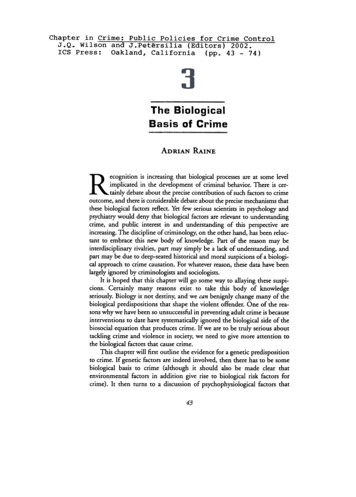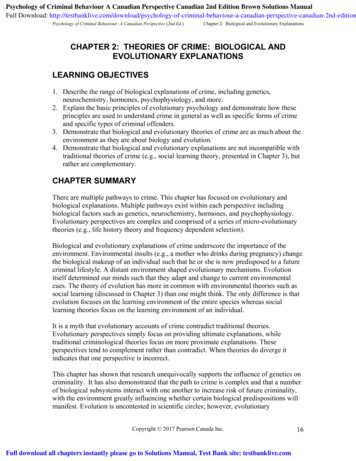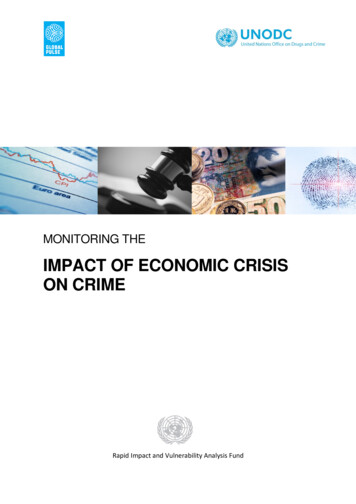
Transcription
Chapterin Crime PublicPoliciesJ.QWilsonand J.Pet rsiliaICS itors)2002.(pp.4374)Biologicalof CrimeADRIANRAINERecognition is increasing that biological processesare at some levelimplicated in the development of criminal behavior. There is certainly debateabout the precisecontribution of such factors to crimeoutcome, and there is considerabledebateabout the precisemechanismsthatthesebiological factors reflect. Yet few serious scientistsin psychology andpsychiatry would deny that biological factors are relevant to understandingcrime, and public interest in and understanding of this perspective areincreasing.The discipline of criminology, on the other hand, has been reluctant to embrace this new body of knowledge. Part of the reason may beinterdisciplinary rivalries, part may simply be a lack of understanding, andpart may be due to deep-seatedhistorical and moral suspicionsof a biological approach to crime causation. For whatever reason,these data have beenlargely ignored by criminologists and sociologists.It is hoped that this chapter will go some way to allaying these suspicions. Certainly many reasons exist to take this body of knowledgeseriously.Biology is not destiny, and we can benig ly change many of thebiological predispositions that shape the violent offender. One of the reasonswhy we have been so unsuccessfulin preventing adult crime is becauseinterventions to date have systematically ignored the biological side of thebiosocial equation that produces crime. If we are to be truly serious abouttackling crime and violence in society, we need to give more attention tothe biological factors that causecrime.This chapter will first outline the evidence for agenetic predispositionto crime. If genetic factors are indeed involved, then there has to be somebiological basis to crime (although it should also be made clear thatenvironmental factors in addition give rise to biological risk factors forcrime). It then turns to a discussion of psychophysiological factors that43
44AdrianRainepredispose to crime and how one heritable influence (low physiologicalarousal) is thought to be the best-replicated biological correlate of antisocial behavior in child and adolescentsamples.Technical advanceshave ledto the ability to look directly at the brains of violent and criminal offenders, and the next section reviews the area of brain imaging and findingsof prefrontal functional and structural deficits in adult offenders. Otherbiological processesare then briefly reviewed, including birth complications, minor physical anomalies, nutrition, hormones, neurotransmitters,and molecular genetics.l Finally, policy implications of this researchwill beoutlined, covering intervention and prevention programs aimed at reducing the effect of biological risk factors, and also implications of brainimaging researchfor the criminal justice system.GENETICSTwinStudiesThe twin method for ascertaining whether a given trait is to any extentheritable makes useof the fact that monozygotic (MZ) or "identical" twinsare genetically identical, having lOO percent of their genes in commonwith one another. Conversely, dizygotic (DZ) or "fraternal" twins are lessgenetically alike than MZ twins, and are in fact no more alike geneticallythan non-twin siblings.When the trait being measured is a dichotomy (for example, criminal/noncriminal), "concordance" rates are calculated for MZ and DZtwins separately.A 70 percent concordance for crime in a set of MZ twins,for example, would mean that if one of the MZ pair is criminal, then thechance of the co-twin being criminal is 70 percent. Similar concordanceratescan be calculated for DZ twins. IfMZ twins have higher concordancerates for crime than DZ twins, then this constitutes some evidence for thenotion that crime has a heritable component. The difference between thesecorrelation coefficients, when doubled, gives an estimate of heritability, orthe proportion of variance in criminality that can be attributed to geneticinfluences (Falconer 1965).Are identical twins more concordant for criminality than fraternaltwins? The answer from many reviews conducted on this expanding fieldis undoubtedly yes. As one example, a review of all the twin studies ofcrime conducted up to 1993 showed that although twin studies varywidely in terms of the age, sex, country of origin, sample size, determination of zygosity, and definition of crime, neverthelessall thirteen studies of
The BiologicalBasisofCrime45crime show greater concordance rates for criminality in MZ as opposedto PZ twins (Raine 1993). If one averagesconcordance rates across allstudies (weighting for sample sizes), these thirteen studies result in concordancesof 51.5 percent for MZ twins and 20.6 percent for DZ twins.Furthermore, the twin studies that have been conducted since 1993 haveconfirmed the hypothesisthat there is greaterconcordancefor antisocial andaggressivebehavior in MZ relative to DZ twins (for example, SlutSkeet al.1997; Eley, lichenstein, and Stevenson1999).Twin studies have methodological limitations that restrict the conclusions that can be drawn from individual studies. A very common criticismof twi studies is that MZ twins may share a more common environmentthan bz twins. For example, parents may treat MZ twins in a more similar fashion than DZ twins, thus artificially raising concordance rates inMZ twins. If this were true, the greater concordance for crime in MZtwins may be due more to environmental than genetic factors. Some evidence indicates that this may be the case(Allen 1976).Criticisms such as these tend to lead researchersto discount resultsfrom twin studies as showing evidence for heritability, but there is alsocounterevidence. Grove et al. (1990) studied thirty-two sets of monozygotic twins who were separated and reared apart shortly after birth, andfound statistically significant heritabilities for antisocial behavior in bothchildhood (0.41) and adulthood (0.28). Such evidence for heritabilitycannot be due to being raised in the same environment. Furthermore, onehasto c( nsiderthe methodological problems with twin studies, which candecreaseestimatesof heritability as opposed to artificially increasing them.For example, there is evidence that some twins make attempts to "deidentify" or be different from orie another (Schacter and Stone 1985),while other twin pairs develop opposite (for example, dominant-submissive) role relationships (Moilanen 1987). These effects are expected to begreatcr in MZ pairs, with the result of artificially reducing heritabilityestimates.Though MZ twins are genetically identical, identical twinningcan result in biological differences that can accentuatehuman differences.For example, there is a greater discrepancy in the birthweights ofMZ twinsrelative to DZ twins, and birth complications have been linked to differcnces in behavior and cognition. This nongenetic, biological factor willresult in an exaggeration of behavioral differences in MZ twins and areduction in heritability estimates.The methodological problems of twinstudies are just as likely to decreaseheritability estimates as opposed toi'1ffi!ting them; in all probability these effects tend to cancel each other out.
46AdoptionAdrianRaineStudiesAdoption studies also overcome the problem with tWin studies becausethey more cleanly separateout genetic and environmental influences. Wecan examine offspring who have been separatedfrom their criminal, biological parents early in life and sent out to other families. If these offspringgrow up to become criminal at greater rates than foster children whose biological parents were not criminal, this would indicate a genetic influencewith its origin in the subject's biological parents.A variation of this type of study is the "cross-fostering" technique thathasbeen usedextensivelyin experimental genetic studiesof animals. Appliedto humans, the offspring whose biological parents are criminal or noncriminal are raisedby parentswho themselvesare either criminal or noncriminal.This 2 x 2 design capitalizeson what is effectively a natural experiment, andallows for a more systematicexploration of genetic and environmental influences.As will be seenlater, this method also allows an assessmentof possibleinteractions between genetic and environmental influences.A good example of a cross-fosteringadoption study is a classic studyconducted by Mednick et al. (1984), illustrated in Table 3.1. Theseresearchersbased their analyseson 14,427 adoptions that took place inDenmark between 1927 and 1947. Infants were adopted out immediately in25.3 percent of cases,50.6 percent within one year, 12.8 percent in thesecondyear,and 11.3 percent after agetwo. Court recordswere obtained on65,516 biological parents, adoptive parents, and adopteesin order to assesswhich subjectshad convictions. When both adoptive and biological parentswere noncriminal (neither genetic nor environmental predispositions present), 13.5 percent of the adopteeshad a criminal record. This increasedto14.7 percent When adoptive parents only were criminal, meaning that anenvironmental but not genetic effect was operating. When only the biological parents were criminal, the conviction rate in the adoptees increasedto20.0 percent. When both adoptive and biological parents were criminal(both genetic and environmental predispositions present), the convictionrate increasedto 24.5 percent.The effect of an adopted child having a criminal biological parent was associatedwith a statistically significant increaseinthe likelihood of the adoptee becoming criminal.While this is but one example, a review of fifteen other adoption studies conducted in Denmark, Sweden,and the United Statesshows that all butone find a genetic basisto criminal behavior (Raine 1993). Importandy, evidence for this genetic predisposition has been found by severalindependentresearchgroups in severaldifferent counuies. These data, therefore, provideevidencethat the basic finding is robust. Interestingly, the three studies that
The BiologicalBasisof47CrimeTable 3.1ResuJtsof Cross-Fostering Analyses (Percentagesrefer tothe proportion of adoptees who had court convictions.)AREPARENTSBIOLOGICALCRIMINAL?SOURCE: Mednick, Gabrielli, and Hutchings (1984).had a large enough sample size to separateviolent from nonviolent, pettyproperty crime found that there is heritability for petty property crimes butnot for violent crimes (Bohman et al. 1982; Mednick et al. 1984; Sigvardsson et al. 1982). On the other hand, an adoption study by van den Oord,Boomsma, and Verhulst (1994) found heritability of 70 percent for aggressivebehavior compared to 39 percent for delinquency. Consequently, whilethere is very clear evidence for a genetic basis to adult criminal offending,there is currently some question as to whether adoption studies of violentadult offending in particular show a genetic basis.One of the key themes of this chapter is the notion that the interactionbetWeenbiological and social factors may be particularly important. Thisconcept is well illustrated in a cross-fostering analysis of petty criminality(Cloninger et al. 1982), results of which are illustrated in Figure 3.1.Swedish adoptees (N 862) were divided into four groups depending onthe presenceor absenceof (1) a congenital predisposition (that is, whetherbiological parents were criminal) and (2) a postnatal predisposition (howthe children were raised by their adoptive parents). When both heredityarid environmental predispositional factors were present, 40 percent of theadopteeswere criminal compared to 12.1percent with only genetic factorspresent,6.7 percent for those with only a bad family environment, and 2.9percent when both genetic and environmental factors were absent. Thefact that the 40 percent rate for criminality when both biological and environmental factors are present is greater than the 18.8 percent rate given bya combination of "congenital only" and "postnatal only" conditions indicatesthat genetic and environmental factors are interacting.
48AdrianRaineFurther analysesindicated that the occupational status of both biological and adoptive parents were the main postnatal variables involved in thisnonadditive interaction. Cloninger and Gottesman (1987) later analyzeddata for femaleswith larger sample sizes.As would be expected,these crimerates in female adopteesare much lower than for males, but the sameinteractive pattern is present: Crime rates in adoptees are greatest when bothheritable and environmental influences are present, with this interactionaccounting for twice as much crime as is produced by genetic and environmental influences taken alone.Evidence for gene x environment interaction is also provided byCadoret et al. (1983), who presented data from three adoption studies.When both genetic and environmental factors are present, they account fora greater number of antisocial behaviors than either of these two factorsacting alone. Crowe (1974) also found some evidencefor a gene x environment interaction in his analysis of adopted-away offspring of femaleprisoners, though this trend was only marginally significant (p .10).Cadoret et al. (1995) in an adoption study of 95 male and 102 femaleadoptees whose parents had either antisocial personality and/or alcoholabuse showed that parental antisocial personality predicted increasedaggressionand conduct disorders in the offspring-illustrating evidence forgenetic processes.But in addition, adverseadoptive home environment wasfound to interact with adult antisocial personality in predicting increasedaggressionin the offspring, that is, a gene x environment interaction effect.A related but different concept is that of gene-environment correlations. An interesting example of this is a study by Ge et al. (1996), whoshowed that the adopted-awayoffspring of biological parents who had antisocial personality I substanceabusewere more likely to show antisocial andhostile behaviors in childhood. This helps establish genetic transmission ofchildhood antisocial behavior. In addition, an association was foundbetween antisocial behavior in the biological parent and the parentingbehaviors of the adoptive parents. This can be explained by a transmissionpathway in which the biological parent contributes a genetic predispositiontoward antisocial behavior in the offspring. The antisocial offspring then inturn elicit negative parenting behaviors in the adoptive parents. This studyprovides direct evidence of an "evocative" gene-environment correlation,and suggeststhat the association between negative parenting in the adoptive parent and antisocial behavior in the child is mediated by geneticprocesses.One of the goals of future behavior genetic studies should be tofurther examine the interplay between genesand environment in this fashion. More generally,there are likely to be future exciting developmentswith
TheBi%gica/BasisofCrime49Genetic x EnvironmentalInteractionin Male Adoptees(Cloninger et al. vel of Predispositionin Female%Genetic x EnvironmentalInteractionAdoptees(Cloningerand talBothLevel of PredispositionFigure 3.1Results of a Cross-FosteringAnalysisbetween Genetic and EnvironmentalIndicatingEvidence for an InteractionFactors in (a) Males and (b) Females.SOURCES: Cloninger and Gottesman (1987); Cloninger et al. (1982).
50AdrianRainerespect to identifying the specific geneswhich give rise to the risk factorsthat shapecriminal behavior (seesection on neurogenetics).PSYCHOPHYSIOLOGYSince the 1940s an extensive body of researchhas been built up on thepsychophysiological basis of antisocial, delinquent, criminal, and psychopathic behavior. For example, there have been at least 150 studies onelectrodermal (sweat.rate) and cardiovascular (heart rate) activity in suchpopulations, and in electroencephalographic (EEG) research alone therehave been hundreds of studies on delinquency and crime (Gale 1975).This body of researchhas received little attention in the broader field ofcriminology, and is rarely referred to in textbooks on crime. One purposeof this chapter is to bring this body of knowledge to the attention of thismore general audience.Definitions of psychophysiology vary, but one useful perspective outlined by Dawson (1990) is that it is "concerned with understanding therelationships berween psychological states and processeson the one handand physiological measureson the other hand" (p. 243). Psychophysiologyis uniquely placed to provide important insights into criminal behaviorbecauseit rests at the interface berween clinical science, cognitive science,and neuroscience (Dawson 1990). Thus, it is sometimes easier to see therelevance of this research for crime relative to biochemistry researchbecauseconcepts in psychophysiology are more easily linked to broaderconcepts such as learning, emotion, arousal, and cognition.There are many psychophysiological correlates of antisocial, criminal,and psychopathic behavior.2 The focus here will lie with one particularpsychophysiological construct, low arousal, because-as will becomeclear-it is the strongest psychophysiological finding in the field of antisocial and criminal behavior.EEG UnderarousalOne influential psychophysiological theory of antisocial behavior is thatantisocial individuals are chronically underaroused.Traditional psychophysiological measuresof arousal include heart rate, skin conductance activity,and electroencephalogram(EEG) measured during a "resting" state. Lowheart rate and skin conductance activity, and more excessiveslow-waveEEG(delta activity with a frequency of 1-4 cyclesper second [cps], 4-7 cps thetaactivity, and 8-10 cps slow alpha) indicate underarousal, that is, less than
The BiologicalBasisofCrime51averagelevels of physiological arousal. Most studies tend to employ singlemeasuresof arousal, although studies that employ multiple measuresare ina stronger position to test an arousaltheory of antisocial behavior.EEG is recorded from scalp electrodesthat measurethe electrical activity of the brain. Literally hundreds of studies assessingEEG in criminals,delinquents, psychopaths,and violent offendershavebeendone over the pastsixty years,and it is clear that a large number of them implicate EEG abnormalitiesin violent recidivistic offending. As examples, Bach-y-Rita et al.(19n)and Hill and Pond (1952) examined large samplesof violent offenders and observedEEG abnormalities in about 50 percent of the cases,withthe most common abnormality being excessiveslow-wave EEG (underarousal).These findings have been supported by studies of murderers andother violent offenders (for example,Mark and Ervin 1970; Williams 1969).Fishbein et al. (1989), in a sample of 124 adult male drug abusers,foundthat aggressionwas associatedwith increasedslow-wave theta activity anddecreasedalpha, indicating underarousal. Convit, Cwbor, and Volavka(1991) observedthe samepattern within a sample of psychiatric inpatients;the number of instancesof violence on wards was related to increasedlevelsof delta activity and lower levels of alpha. Drake, Hietter, and Pakalnis(1992) found that, while none of 24 depressedpatients and only I of 20headachecontrol patients had abnormal EEGs, 7 of23 patients with eitherintermittent explosive disorder or episodic dyscontrol (brief periods wherethe individual lacks control) had diffuse or focal slowing in EEG. Murderershavemore recently been shown to have more EEG deficits in the right thanthe left hemisphereof the brain, with multiple abnormalities being especiallypresentin the right temporal cortex (Evansand Park 1997). On the otherhand, Pillmann et al. (1999) showed greater abnormalities in the left temporal region of repeatviolent offenders.Generally speaking, the prevalence of EEG abnormalities in violentindividuals in this large literature rangesfrom 25 percent to 50 percent, withthe rate of abnormalities in normals estimated as ranging from 5 percentto 20 percent. The bulk of this researchimplicated the more frontal regionsof 1he brain, areasthat regulate executive functions such as planning anddecision making. Similar conclusions are drawn by Volavka (1987) andMilstein (1988) for crime in generaland violent crime in particular.CardiovascularUnderarousalData on resting heart rate provides striking support for underarousal inantisocials. Indeed, the findings for heart rate level (HRL) on non-
52AdrianRaineinstitutionalized antisocials are believed to represent the strongest andbest replicated biological correlate of antisocial behavior. A detailed reviewof these studies and full theoretical and methodological considerationsare given in Raine (1993) and Raine (1996a). Briefly, twenty-four studiesof resting heart rate and conduct-disordered, delinquent, and antisocialchildren and adolescents performed between 1971 and 1996 yieldedtwenty-nine independent samplesof antisocials and a total of thirty-eighteffect sizes (a measure of the strength of the effect). Of the thirty-eighteffect sizes,thirty-two were significant and positive (that is, low hean rateassociatedwith antisocial behavior), while only one was significant and inthe negative direction. This latter, unexpected finding (Zahn and Kruesi1993) was interpreted by its authors as possibly due to biased referral tothe clinic by anxious, easily stressedparents who worried about their childand who may genetically transmit high HRL to their child.A low resting heart rate is the best-replicatedbiological marker of antisocial and aggressivebehavior in childhood ;md adolescent communitysamples.Resting HRL was measured in a wide variety of ways, includingpolygraphs, pulse meters, and stopwatches.A wide number of definitions ofantisocial behavior are used, ranging from legal criminality and delinquencyto teacher ratings of antisocial behavior in school, self-report socializationmeasures,diagnostic criteria for conduct disorder, and genetically inferredlaw breaking (i.e. offspring of criminals). Subjects were also assessedin awide variety of settings, including medical interview, study office, school,university laboratory, and hospital. In the light of such variability, it is sucprising that consistency in findings have been obtained, attesting to therobustness of the observed effects. Importantly, there has also been goodcross-laboratoryreplication of the finding, and it has also been found in sixdifferent countries-England, Germany, New Zealand, the United States,Mauritius, and Canada-illustrating invariance to cultural context.The link between low heart rate and crime is not the result of suchthings asheight, weight, body bulk, physical development, and muscle tone(Raine, Venables, and Mednick 1997; Raine, Buchsbaum and La Casse1997; Wadsworth 1976; Farrington 1997); scholasticability and IQ (Raine,Venables,and Williams 1990; Farrington 1997); excessmotor activity andinattention (Raine, Venables,and Mednick 1997; Farrington 1997); drugand alcohol use (Raine, Venables,and Mednick 1997); engagementin physical exerciseand sports (Wadsworth 1976; Farrington 1997); or low socialclass,divorce, family size, teenagepregnancy,and other psychosocialadversity (Raine, Venables, and Williams 1990; Wadsworth 1976; Farrington1997). Intriguingly, an unusual and important feature of the relationship is
TheBiologicalBasisofCrime53its diagnostic specificity. No other psychiatric condition has been linked tolow resting heart rate. Other psychiatric conditions, including alcoholism,depression, schizophrenia, and anxiety disorder, have, if anything, beenlinked to higher (not lower) resting heart rate.Low heart rate has been found to be an independent predictor ofviolence. Out of forty-eight psychosocial and individual measures, onlytWo risk factors were related to violence independently of all other riskfactors in all six analyses:low resting heart rate and poor concentration(Farrington 1997). Indeed, low heart rate was more strongly related toboth self-report and teacher measuresof violence than having a criminalparent. These findings led Farrington (1997) to conclude that low heartrate may be one of the most important explanatory factors for violence (p.99). There is also a substantial heritability for resting heart rate, suggestingthat it may be a genetic marker for antisocial and criminal behavior (Raineet al. 1990). Furthermore, the offspring of criminal parents have beenshown to have low resting heart rate in tWo separatestudies (Farrington1987; Venables 1987). Low heart rate characterizesfemale as well as maleantisocial individuals. Severalstudies, including tWo that are prospective,have now establishedthat, within females, low heart rate is linked to antisocial behavior (Raines et al. 1990; Maliphant, Hume, and Furnham1990; Raine, Venables, and Mednick 1997; Moffitt and Caspi In press).ProspectiveStudiesofUnderarousalOne of the major difficulties in trying to draw conclusions on the psychophysiological basisof criminal behavior is that most studies conductedto date have been nonprospective and have utilized institutionalized populations. In addition, most studies report results from only one of the threemost commonly measured psychophysiological responsesystems (electrodermal, cardiovascular,and cortical). Prospectivelongitudinal research-thatis; researchthat follows people forward through their lives-a1lows for muchmore powerful statements to be made about predispositions for criminalbehaviorand to elucidate causeand effect relationships;but becauseprospective researchis more difficult to execute,there are few such studies.Regarding heart rate levels, five prospective studies of heart rate alonehaveconfirmed that low heart rate is predictive of later antisocial behavior,while five additional prospective studies also show significant effects forc)ectrodermal and electrocortical arousal. Wadsworth (1976) found thattower resting heart rate in unselectedeleven-year-old schoolboys predictedde)inquency measured from ages eight to twenty-one. The very lowest
54AdrianRaineHRU were found in those who committed nonsexual violent criminaloffensesas adults. Similarly, Farrington (1987) found that resting heart ratemeasured at age eighteen to nineteen in noninstitutionalized males predicted to violent criminal offending at age tWenty-five. With respect toEEG, tWo separatestudies haveshown that slow alpha frequency predicts toadult thievery in a sample of 129 Danish thirteen-year-old boys (Mednicket al. 1981) and 571 Swedish one- to fifteen-year-old boys (Petersenet al.1982). Low heart rate characterizeslife-course-persistentantisocial individuals in particular; Moffitt and Caspi (In press) have recently found thatlow resting heart rate assessedat agesseven,nine, and eleven is particularlycharacteristic of life-course-persistent offenders, a group who have beenhypothesized as having early neurobiological deficits (Moffitt 1993).As with most other studies, evidence in these prospective studies forprediction to antisocial behavior is based on only one measure of arousal.One nine-year prospective study of crime by Raine, Venables, andWilliams (1990) has shown, however, that low resting heart rate, low resting skin conductance activity, and excessive slow-wave theta EEG(indicating underarousal) measured at age fifteen in normal unselectedschoolboys predicted criminal behavior at age tWenty-four. These threemeasurescorrectly classified 74.7 percent of all subjects as criminal/noncriminal, a rate significantly greater than chance (50 percent). In the totalpopulation, the three arousal measureswere statistically independent; thefact that they all independently predicted to criminal behavior indicatesstrong support for an arousal theory of criminal and antisocial behavior(although this finding also cautions against the use of a simplistic, unitaryarousal concept in explaining crime). Group differences in social class,academic ability, and area of residence were not found to mediate thelink betWeenunderarousal and antisocial behavior.InterpretationsFearlessnessofandLow Arousal:Stimulation-SeekingTheoriesWhy should low arousal and low heart rate predispose to antisocial andcriminal behavior? There are two main theoretical interpretations.Fearlessnesstheory indicates that low levels of arousal are markers of lowlevels of fear (Raine 1993; Raine 1997). For example, particularly fearlessindividuals such as bomb disposal experts who have been decorated fortheir bravery have particularly low HRU and reactivity (Cox et al. 1983;O'Connor, Hallam, and Rachman 1985), as do British paratroopers decorated in the Falklands War (McMillan and Rachman 1987). A fearlessness
TheBi o logicatB asisofGrime55interpretation oflow arousal levels assumesthat subjectsare not actually at"rest," but that instead the rest periods of psychophysiological testing represent a mildly stressful paradigm and that low arousal during this periodindicates lack of anxiety and fear. Lack of fear would predisposeto antisocial and violent behavior becausesuch behavior (for example, fights andassaults)requires a degreeof fearlessnessto execute,while lack of fear, especially in childhood, would help explain poor socialization since low fear ofpunishment would reduce the effectivenessof conditioning. Fearlessnesstheory receives support from the fact that autonomic underarousal alsoprovides the underpinning for a fearlessor uninhibited temperament ininfancy and childhood (Scarpaet al. 1997; Kagan 1994).A second theory explaining reduced arousal is stimulation-seekingtheory (Eysenck 1964; Quay 1965; Raine 1993; Raine, Reynolds,Venables, et al. 1998). This theory argues that low arousal represents anunpleasant physiological state; antisocials seek stimulation in order toincreasetheir arousal levels back to an optimal or normal level. Antisocialbehavior is thus viewed as a form of stimula
the biological factors that cause crime. This chapter will first outline the evidence for agenetic predisposition to crime. If genetic factors are indeed involved, then there has to be some biological basis to crime (although it should also be made clear that environmental factors in addition give rise to biological risk factors for crime).










